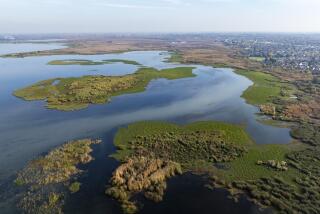Readers React: More casualties of rapid climate change: saltwater marshes and coastal tourism spots
To the editor: Except for environmentalists who understand their value, most of us, in our ignorance, would probably welcome the rising sea covering over those messy salt marshes. (“Salt marshes will vanish in less than a century if seas keep rising and California keeps building, study finds,” Feb. 21)
I live near the Back Bay ecological reserve in Newport Beach and didn’t realize its role in purifying the air, cleansing urban runoff before it gets into the sea and reducing storm surge damage. Newport is only now beginning to face up to the devastation climate change is bringing.
At a January forum on sea level rise, city staff warned our community that seas could rise more than five feet by 2100, flood our world-famous beach and harbor communities and cost citizens up to $1 billion trying to arm themselves. How many more alarming scientific reports will it take before citizens demand government action to price carbon pollution and transition us to clean energy sources?
Robert Taylor, Newport Beach
..
To the editor: It’s curious that one of this report’s authors, Richard Ambrose of the Institute of the Environment and Sustainability, is also a chief architect of what Sierra Club and many others see as a misguided and destructive plan to lower the elevations of salt marsh habitats at the Ballona Wetlands in order to invite more seawater inland.
UCLA geography professor Glen MacDonald has it right when he laments, “We’re essentially drowning the marshes” — an outcome that would be repeated at the Ballona Wetlands if Ambrose has his way.
We hope Ambrose and others of his thinking will wake up to this research and other new science that has been ignored to date and realize if we want to preserve coastal ecosystems that remain — and not only salt marshes, but also wet meadows, seasonal ponds, coastal plain scrub, coastal grasslands and the wildlife that require this habitat — that the “no bulldozing or excavation” approach is a more prudent one.
Marcia Hanscom, Playa del Rey
The writer chairs the Sierra Club Ballona Wetlands Restoration Committee.
..
To the editor: The hubris of environmental activists is truly astonishing. They genuinely believe that the saltwater marsh degradation is a problem to be solved.
It’s an extraordinarily complex ecosystem that makes up a minuscule percentage of the West Coast shoreline. Why bother? These ecosystems have come and gone before for many millennia. If the current ones go away, they will be replaced when conditions allow.
How typical of environmentalists: Pose a solution in search of a problem.
David Pohlod, Oak Park
Follow the Opinion section on Twitter @latimesopinion and Facebook
More to Read
A cure for the common opinion
Get thought-provoking perspectives with our weekly newsletter.
You may occasionally receive promotional content from the Los Angeles Times.






